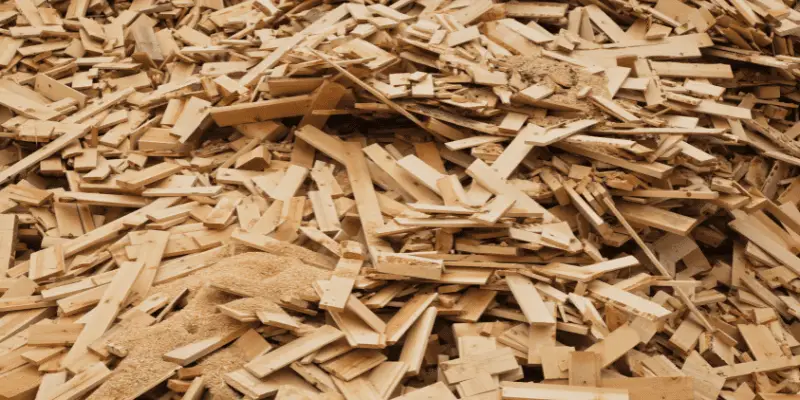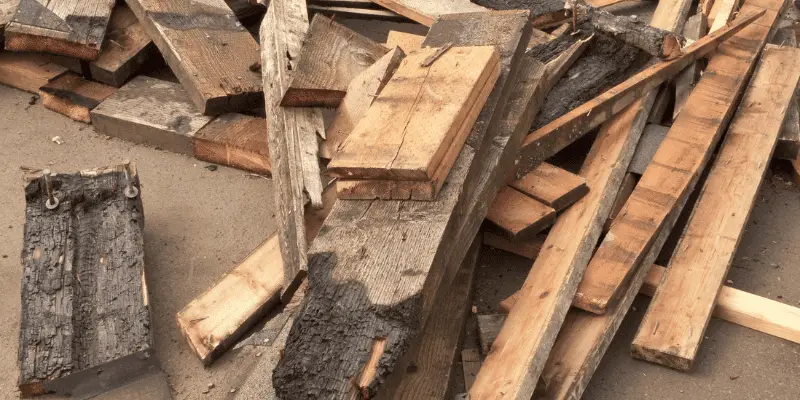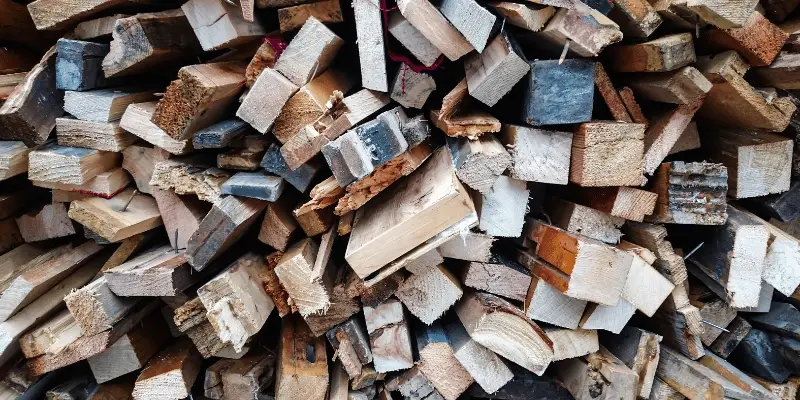Wood is recyclable. Wood can be recycled and repurposed into various products, including particleboard, mulch, and paper. Recycling wood helps reduce waste in landfills, conserves resources, and promotes sustainability. It’s important to sort and dispose of wood materials properly.
Are Pieces of Wood Recyclable?
Pieces of wood are generally considered recyclable, especially when they are clean, untreated, and free from contaminants. Wood recycling involves collecting and repurposing wood waste such as lumber scraps, pallets, and discarded furniture into new products or energy sources.
These pieces can be transformed into various useful materials, including mulch for landscaping, composite wood products, or biomass energy through processes like incineration or gasification.
By recycling wood, we reduce the volume of wood waste in landfills, conserve natural resources, and promote sustainable practices in the woodworking and construction industries. However, it’s essential to check local recycling guidelines to ensure proper disposal and processing of wood waste in your area.
Cured Wood Recyclable?
Cured wood, which refers to wood that has been dried and prepared for use in construction or other applications, is recyclable to some extent. While it may not go through the same recycling process as materials like paper or aluminum, cured wood can still be repurposed and reused.
Clean, untreated cured wood, such as lumber offcuts or old furniture, can be recycled by converting it into various products, like particleboard, fiberboard, or even biomass energy.
Additionally, reclaimed cured wood can be used for creating new furniture, flooring, or decorative elements, contributing to sustainability and reducing the demand for fresh timber harvesting.
Wood Recyclable Symbol?
Unlike materials like plastic, glass, or metal, wood does not have a universally recognized recycling symbol like the well-known chasing arrows. Recycling symbols are typically associated with materials that go through a specific recycling process.
Wood recycling usually doesn’t involve using a symbol but rather follows established practices and guidelines for recycling clean, untreated wood. Local recycling facilities may have their own labels or symbols to indicate where and how to dispose of wood waste properly.
It’s essential to check with your local waste management or recycling authorities for specific instructions on recycling or disposing of wood in your area.

Wood Pallet Recycling?
Wood pallet recycling involves reusing and repurposing wooden pallets to extend their lifespan and minimize waste. This process includes collecting used pallets, repairing any damaged ones, and reintroducing them into circulation for transporting goods and materials.
Pallets that are beyond repair can be dismantled, and the wood can be repurposed for various applications, such as furniture, flooring, or crafting. The recycling of wood pallets reduces the need for new timber, conserves natural resources, and decreases the volume of wood waste in landfills.
Additionally, it promotes sustainability and cost-effectiveness in the logistics and manufacturing industries, contributing to a more circular and environmentally friendly approach to material handling.

Can Wood be Recycled?
Wood recycling is an essential part of sustainable resource management. The process involves diverting wood waste from landfills and repurposing it for various applications. Clean, untreated wood scraps, pallets, and discarded furniture can be transformed into valuable products, reducing the demand for new timber harvesting.
By recycling wood, we contribute to environmental conservation, energy efficiency, and the reduction of greenhouse gas emissions.
Whether it’s turning wood into biomass energy, creating new wood-based products, or repurposing reclaimed wood for furniture and decorative elements, recycling plays a significant role in promoting eco-friendliness and minimizing the environmental impact of the wood industry.
Clean Wood Recycling?
Clean wood recycling refers to the process of recycling untreated, unpainted, and uncontaminated wood materials, such as lumber scraps, pallets, and wooden furniture, into new products or energy sources. This environmentally responsible practice involves collecting, sorting, and processing clean wood waste in ways that minimize environmental impact.
Clean wood can be transformed into various useful items, including mulch for landscaping, particleboard, and fiberboard, as well as biomass energy through incineration or gasification.
By focusing on clean wood recycling, we reduce the need for fresh timber harvesting, conserve natural resources, and decrease the volume of wood waste sent to landfills, contributing to a more sustainable and circular approach to wood resource management.

FAQ
Is Wood Recyclable or Garbage?
Wood can be both recyclable and considered garbage, depending on its type and condition. Clean, untreated wood, such as lumber scraps and pallets, is recyclable and can be repurposed into various wood products, mulch, or biomass energy.
However, if wood is contaminated with paint, varnish, or other treatments, it may be considered garbage because recycling facilities may not accept it due to the presence of harmful chemicals. It’s important to differentiate between recyclable and non-recyclable wood and dispose of it accordingly.
Properly sorted and clean wood can be recycled, contributing to resource conservation, while contaminated or treated wood should be disposed of as garbage or hazardous waste.
Is Wood Considered Recyclable?
Wood is considered recyclable, but its recycling process differs from that of conventional materials like paper, glass, and metal. While it’s not suitable for standard curbside recycling programs due to its size and composition, wood can be repurposed and reused in various ways.
Recycling wood often involves chipping it into mulch for landscaping, converting it into biomass energy, or manufacturing new wood-based products such as particleboard and fiberboard. Reclaimed wood can also be transformed into furniture, flooring, and architectural elements, contributing to sustainable construction practices.
By recycling wood, we minimize the environmental impact of deforestation and reduce the amount of wood waste sent to landfills, promoting a more circular and eco-friendly approach to resource management.
Can Wood be Recycled?
Wood recycling is a sustainable practice that contributes to environmental conservation. By reusing and repurposing wood products, we reduce the demand for fresh timber harvesting, which can lead to deforestation and habitat destruction. Wood waste, such as discarded furniture, construction materials, and pallets, can be transformed into useful products, extending their lifespan and reducing the need for new resources.
Whether it’s chipping wood into mulch for landscaping, manufacturing new particleboard, generating biomass energy, or repurposing reclaimed wood for creative projects, recycling wood is a responsible approach that benefits both the environment and the economy.
Additionally, recycling wood minimizes the volume of waste in landfills and promotes sustainability in various industries.
Can you Put Wood in the Recycling Bin?
In most standard curbside recycling programs, you should not put wood in the recycling bin. Wood is typically not accepted with traditional recyclable materials like paper, glass, plastic, and metal. It is biodegradable and can be too large or heavy for standard recycling facilities to process effectively.
However, some communities have separate wood recycling programs or designated drop-off locations where you can dispose of clean, untreated wood, such as lumber scraps or pallets.
Always check with your local recycling guidelines or contact your waste management authority for specific instructions on recycling or disposing of wood in your area to ensure you are following the appropriate waste disposal practices.
Can Wood Go Into the Recycling Bin?
Whether wood can go into the recycling bin depends on the specific guidelines of your local recycling program. In many standard curbside recycling programs, wood is not accepted in the regular recycling bin, as it is typically not processed with traditional recyclable materials like paper, glass, plastic, and metal.
Wood is biodegradable and can be too large or heavy for standard recycling facilities to handle. However, some areas offer separate wood recycling programs or drop-off locations for clean, untreated wood, such as lumber scraps or pallets.
It’s essential to check your local recycling guidelines and contact your waste management authority for specific instructions on recycling or disposing of wood in your region.
Can you Recycle Wood in a Blue Bin?
Recycling wood in a standard blue bin, typically used for curbside recycling programs, is generally not recommended. Blue bins are primarily meant for recyclable materials like paper, cardboard, glass, plastic, and metal. Wood is biodegradable and often too large and heavy to be processed through conventional recycling systems.
However, some communities offer special wood recycling programs or drop-off locations where you can dispose of clean, untreated wood, such as lumber scraps or pallets. Additionally, wood can be repurposed or reused for various DIY projects, reducing the need for disposal.
Always check your local recycling guidelines or contact your waste management authority for specific instructions on recycling or disposing of wood in your area.
Are Wood Cutting Boards Recyclable?
Wood cutting boards are typically not recyclable in the traditional sense, as they are not generally accepted in municipal recycling programs. However, there are alternative ways to handle them in an environmentally friendly manner.
One option is to repurpose or upcycle old wooden cutting boards into various household items, such as serving platters, shelves, or decorative pieces. You can also check with local woodworking or craft organizations, as they may be interested in reclaiming old wooden boards for their projects.
If a wooden cutting board is beyond repair or reuse, it can be disposed of in a landfill, where it will biodegrade over time, making it a more eco-friendly option compared to plastic cutting boards.


